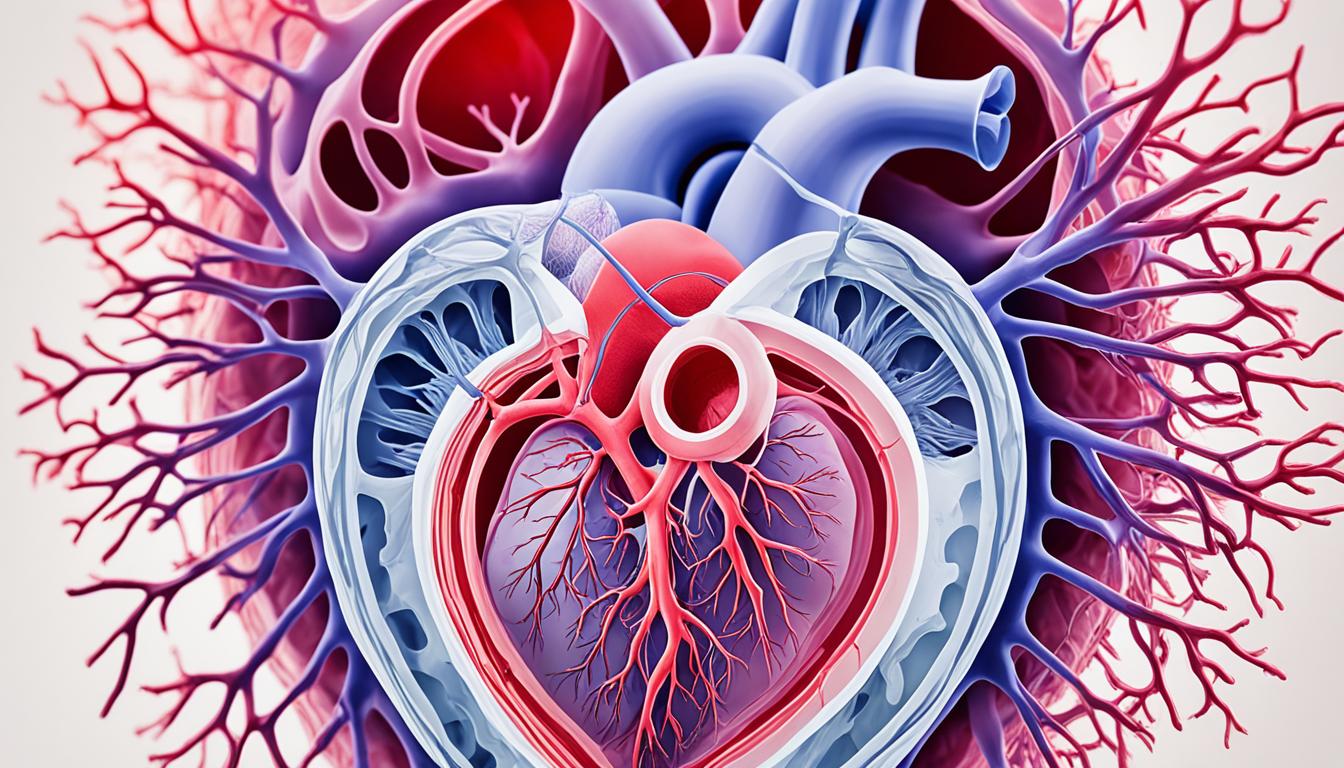Mitral valve disease affects the mitral valve. This valve is like a one-way door in the heart. It controls the flow of blood between the left heart chambers. Conditions like mitral regurgitation and mitral stenosis are part of this disease.
In mitral regurgitation, the valve doesn’t close right. Blood leaks back into the left chamber. In mitral stenosis, the valve gets thick and narrow, blocking blood flow.
Causes of this disease can be from birth (congenital), rheumatic heart disease, or other health issues. Signs of a problem can be feeling tired, having heart murmurs, or finding it hard to breathe. Doctors use tests like echocardiography and X-rays to diagnose it.
There are different ways to treat mitral valve disease. This includes taking medication or having surgery. New treatments like stem cell therapy are also becoming available. They might help especially in cases of congenital heart diseases.
Key Takeaways:
- Mitral valve disease affects the mitral valve, causing symptoms such as fatigue, palpitations, and shortness of breath.
- Mitral regurgitation and mitral stenosis are two common forms of mitral valve disease.
- Diagnosis involves various tests, including echocardiography, X-rays, electrocardiograms, and stress tests.
- Treatment options include medication, percutaneous interventions, and surgical interventions.
- Stem cell therapy and tissue engineering show promise in the treatment of mitral valve defects.
Diagnosis of Mitral Valve Prolapse and Treatment Options
Mitral valve prolapse is a type of heart disease. It affects the mitral valve, making its leaflets bulge into the heart’s left atrium. Doctors diagnose this issue using tests like echocardiography. This test makes detailed pictures of the heart’s structures and how blood flows through them. X-rays and electrocardiograms can also help with the diagnosis by offering more insights.
Treating mitral valve prolapse depends on how bad the symptoms are. If symptoms are mild, just keeping a close eye on it might be enough. But if the symptoms are serious, your doctor may prescribe drugs. These drugs work on heart irregularities and lower the clot risk. You might take beta blockers, aspirin, or anticoagulants.
Sometimes, surgery is needed for severe mitral valve prolapse. There are various ways to fix a mitral valve. Doctors might remove tissue, fix holes, or use artificial parts to repair it. If the valve can’t be fixed, you may need a new valve. This new valve can be mechanical or made from tissue.
There are less invasive methods to treat mitral valve prolapse too. For example, there’s valvuloplasty, where a balloon is used to open up the valve. And then, there’s the MitraClip procedure. This involves placing a clip on the valve’s leaflets to lessen leaking.
Treatment Options for Mitral Valve Prolapse:
- Medication management: Beta blockers, aspirin, and anticoagulants
- Surgical interventions: Mitral valve repair or replacement
- Percutaneous interventions: Valvuloplasty or MitraClip
Once diagnosed with mitral valve prolapse, talking to a doctor is very important. Your doctor can then suggest the best way to deal with your specific case and symptoms.
| Diagnostic Methods | Advantages | Limitations |
|---|---|---|
| Echocardiography | Noninvasive, provides detailed images of heart structures and blood flow | Dependent on operator expertise, may have limited accessibility in some regions |
| X-ray | Provides a basic visualization of the heart and lungs | Limited detail, exposure to radiation |
| Electrocardiogram | Records electrical activity of the heart, helps evaluate heart rhythm | May not detect all abnormalities, requires proper electrode placement |
| Stress test | Assesses heart function during physical activity | May not detect symptoms if the patient is asymptomatic during the test |
Advancements in Stem Cell Therapy and Tissue Engineering for Mitral Valve Disease
In the last few years, we’ve seen big leaps in stem cell therapy and tissue engineering. They offer hope for treating mitral valve disease, especially with congenital heart defects. Stem cell therapy involves using different stem cells to make living material. This material, called cellularized grafts, is put into the heart. The grafts can grow and change with the heart, maybe working better and lasting longer than traditional surgeries.
Using cardiac stem cells among the mesenchymal and stromal cells gives us a chance for new heart muscle growth. Also, endothelial cells and vascular progenitors help make sure the grafts get blood flow efficiently. By adding stem cell work to surgery, we can meet the needs of patients with heart defects. This includes mitral valve issues.
Adding scaffolds and biomaterials to tissue engineering boosts our ability to regrow parts of the heart. These new ways might help fix the mitral valve better and make life better for those with the disease.

